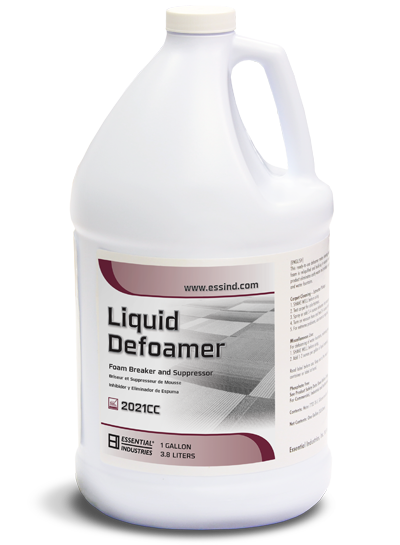Common Implementations of Chemical Defoamer Across Different Fields
Common Implementations of Chemical Defoamer Across Different Fields
Blog Article
Comprehending Just How a Chemical Defoamer Functions to Boost Industrial Processes
Chemical defoamers play a critical function in maximizing industrial procedures by effectively alleviating foam-related obstacles. Their capability to lower surface area tension and interrupt bubble development equates into smoother operations and boosted performance. The systems behind their action and the variety of readily available solutions require a closer examination. Recognizing these facets can expose considerable insights into not just improving manufacturing yet additionally achieving cost financial savings throughout several fields. What stays to be discovered is how these defoamers can be customized to fulfill details operational needs.
What Is a Chemical Defoamer?
A chemical defoamer is a material particularly created to get rid of the formation or reduce of foam in numerous industrial procedures. Frothing can hinder manufacturing efficiency, impacting the top quality and performance of items in fields such as food and drink, drugs, and wastewater therapy. Defoamers are critical in these applications, as too much foam can bring about operational obstacles, such as overflow, minimized blending effectiveness, and impeded warmth transfer.
The option of a suitable defoamer is crucial, as various solutions may be customized for particular procedures or kinds of foam. Variables such as compatibility with other ingredients, temperature stability, and the intended application play a considerable duty in the effectiveness of a defoamer.
Systems of Defoaming Action
The devices of defoaming activity involve complex interactions in between the defoamer and the foam structure. At the core of this procedure is the reduction of surface area stress at the interface of the fluid and gas phases. When a defoamer is introduced to a lathering system, it migrates quickly to the surface of the foam bubbles, displacing the supporting agents that add to foam security. This displacement weakens the foam framework, causing bubble coalescence.
As smaller sized bubbles combine into larger ones, the total stability of the foam lessens. In addition, certain defoamers may include hydrophobic elements that enhance their ability to destabilize the foam by producing a barrier that hinders bubble formation. This dual action-- surface area tension reduction and destabilization-- allows for an extra reliable malfunction of foam.

Moreover, the viscosity and dispersing attributes of the defoamer play crucial duties in its effectiveness. A well-formulated defoamer will certainly ensure fast migration and ideal efficiency, reducing foam development during commercial processes. By comprehending these devices, industries can much better pick and use chemical defoamers to enhance functional effectiveness and item high quality.
Kinds Of Chemical Defoamers
Chemical defoamers can be categorized into a number of kinds, each customized to certain applications and foam obstacles. The main classifications consist of silicone-based, non-silicone-based, and powder defoamers.
Silicone-based defoamers are very reliable because of their capacity to spread out swiftly throughout fluid surface areas. They supply excellent foam reductions and security, making them ideal for numerous commercial applications, consisting of adhesives and coatings. Non-silicone-based defoamers, on the various other hand, often depend on organic substances like fatty acids or esters. These are particularly preferred in food and drink industries due to their reduced poisoning and regulative conformity.
Powder defoamers are composed of solid particles that can be contributed to completely dry processes or solutions. They are usually utilized in processes where liquid defoamers might not work, providing a special solution for particular applications, such as in the manufacturing of resource certain types of powders or plastics.
Additionally, each kind of defoamer can be personalized with numerous ingredients to enhance efficiency, such as surfactants or emulsifiers, enabling adaptability in resolving different foaming situations throughout multiple industries.
Applications in Industrial Processes

In the food and beverage industry, defoamers are essential throughout the production of juices, beers, and milk products, where too much foam can impede mixing and purification processes. By lowering foam formation, defoamers help preserve consistent product top quality and enhance processing times.
In pharmaceuticals, the existence of foam during the blending and solution of medicines can influence dosage precision and product security. Defoamers guarantee smooth procedures, thus promoting the manufacturing of high-quality drugs.
Wastewater treatment centers likewise count on defoamers to manage frothing in aeration storage tanks, which can or else decrease therapy efficiency and make complex sludge handling. By effectively handling foam, these chemicals boost the total efficiency of therapy processes and add to governing compliance.

Advantages of Using Defoamers
While foam can offer considerable challenges across numerous industries, using defoamers provides countless benefits that improve functional efficiency and product stability. Defoamers efficiently reduce or remove foam formation, leading to smoother manufacturing procedures and enhanced item high quality. This decrease in foam lessens disruptions throughout production, enabling for constant procedure and enhanced throughput.
In addition, the application of defoamers can bring about cost financial savings by reducing the requirement for excess basic materials and power usage related to foam monitoring. By maximizing the production procedure, manufacturers can accomplish higher yields and lower waste, eventually boosting productivity.
In addition, defoamers add to far view website better tools efficiency. Foam accumulation can bring about clogging, overflow, and devices wear, causing costly downtime and maintenance. By preventing these concerns, defoamers prolong the lifespan of equipment and decrease functional costs.
Conclusion

A chemical defoamer is a material specifically created to remove the development or decrease of foam in different industrial processes. When a defoamer is presented to a lathering system, it migrates check swiftly to the surface of the foam bubbles, displacing the stabilizing representatives that contribute to foam security. A well-formulated defoamer will certainly ensure quick migration and optimum performance, minimizing foam development throughout industrial procedures. Defoamers efficiently remove or minimize foam formation, leading to smoother manufacturing processes and boosted product top quality.In conclusion, chemical defoamers play a crucial role in improving industrial processes by properly decreasing foam development.
Report this page